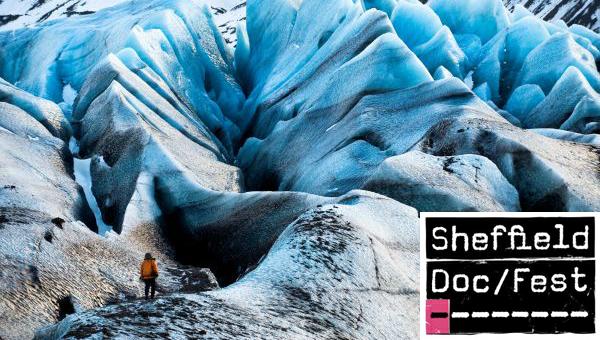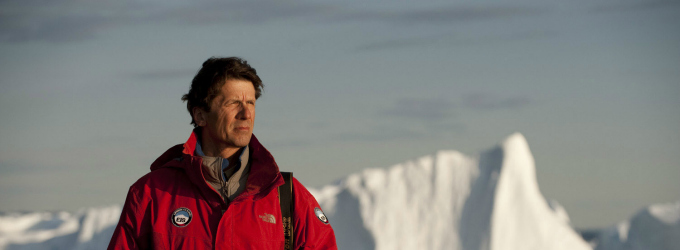httpvh://youtu.be/BJx5cA9fuIU
CHASING ICE exists to show climate change visually. Boy, does it succeed. The film follows National Geographic photographer James Balog’s Extreme Ice Survey, a mission to capture the decline of the world’s glaciers using time-lapse cameras.
One of many astounding images in the film has the team cowering in awe at an iceberg calving from a glacier into the sea. Caught almost by chance, the camera judders toward a growing crack in a distant ice wall. The chunk torn off measures itself in a scale of multiple football pitches. Yet the worst is yet to come. Once released, the leviathan teeters over itself, rolling in the water with an obscene languor. Yet this is a natural event, a by-product of the project, however rarely it may be caught on camera. The real action lies with Balog’s attempt to watch the glaciers wither.
By rights, we should be wary of these vast, cold behemoths. Sadly, the images here say otherwise.
Where AN INCONVENIENT TRUTH had Al Gore’s scary graph, CHASING ICE gets right out there, risks its ass and shoves its snout into the direct effects of heating up the planet’s atmosphere. By rights, we should be wary of these vast, cold behemoths. Sadly, the images here say otherwise.
Following the screening of CHASING ICE at the Sheffield Doc/Fest 2012, we spoke to debut director and member of the Extreme Ice Survey team Jeff Orlowski. Additional material is supplied from the Q&A following one of the film’s screenings at the festival.
David Perilli: What does it feel like being around a glacier calving?
Jeff Orlowski: Physically, when you’re close it feels like a plane is flying over your head. There’s a rumbling sound. It’s so deep and present. It fills you with tension. It’s hard to ignore it when it’s happening.
One of the most amazing things is how long they take to roll over sometimes. Because they’re so, so massive, you actually have gravity as a sense of scale. When you see a piece of ice break off and it takes several seconds for it to hit the water, you recognise how big that piece actually is.
From an emotional perspective, it’s an interesting balance, because there are some juxtaposing, contradictory emotions where we’re excited that we’ve captured these images but the significance and the meaning of it is rather terrifying. We have this mixed sense of being excited, but also recognising what it really means from a human perspective. This whole project has been a balance of those mixed emotions.
DP: I liked the ice in your film. When I think of ice I think of ice cubes. The ice in the film was massive, it was small, it was coloured, it had light refracted through it…
JO: We tried to keep the ice as a character during the film, just how James looks at the ice as a subject in his photography and his portraits. I tried to keep the ice as a character in the narrative of the movie and to really give a point of embrace for people.
“I just didn’t really know what I was in for. I just kind of fell in love with the story.”
DP: How did you join the Extreme Ice Survey?
JO: I met James through a mutual friend, Michael, who introduced all of these guys to the team. Michael helped James build this team of young people who had free time and were dedicated. I met James about a year before the project had started and James was doing the very first trip to Iceland. Michael just pitched to James that he take me along.
And so I was doing everything I could just to get my foot in the door. I volunteered. I just went to Iceland for a week and a half. It was very, very cold. I had all the wrong equipment. People were lending me shell-pants, people were lending me gloves, and I just didn’t really know what I was in for. I just kind of fell in love with the story.
DP: What’s the coldest you’ve been?
JO: Negative forty. Which is the same in Fahrenheit and Celsius. Honestly, after negative ten and negative twenty, it all feels the same. It’s all just very cold.
DP: How did the film emerge?
JO: We just kept shooting all this video footage, just knowing that it was a raw and unique thing we needed to document. About a year and a half, two years into the project, we had so much footage and the time lapses. The important thing was that the time lapses were really starting to tell a great story. We decided at that point that we had the material to make a film. So then I built a team around me, brought on producers, did more fundraising, brought on a writer and brought on an editor. We crafted the story after that point.
One of the challenges that we tried to accomplish with CHASING ICE is, how do you take the subject matter of climate change, which we are so inundated with and tired of, and how do you make it fresh? How do you make it new? How do you get people to see what’s going on and get them to care emotionally about the issues? That was our position with the film to make it a human story and visual.
… we weren’t trying to interview people who oppose climate change in this story. […] We’re trying to tell James’ story.
DP: How did you split documenting the project and actually working on it?
JO: In the beginning we were just documenting everything that James was doing. In fact, because of my position as just a videographer, for much of that there’s almost no footage of me out in the field. So when we were doing the editing it became clear that I had certain experiences that I was the only one who could tell those stories so we did an interview with myself. To see the balance of my own role in the story, I wouldn’t necessarily call it a conflict of interest. I was one of the videographers and I ended up becoming the filmmaker on this process.
The problem I feel with climate change in general is that the journalistic standard traditionally tries to cover both sides of any opinion. And they try and cover one opinion and the opposing opinion. They try and have that balance of the story. But in a field right now like climate change, where you have 97% of the scientists in accordance with one truth and reality, how do you balance out a 50-50 split between 97% of the scientific community and the remaining 3%? It seems unfair that they’re getting equal airtime. So from my perspective we weren’t trying to interview people who oppose climate change in this story. I recognise that this is a opinionated film from my experience having been involved in this project. We’re trying to tell James’ story.
To find out more about CHASING ICE and the Extreme Ice Survey, visit www.chasingice.com and www.extremeicesurvey.org.
CHASING ICE screens at Cambridge Arts Picturehouse at 8pm on Thursday 20th September.




One thought on “Goodbye to glaciers: Chasing Ice”
Comments are closed.